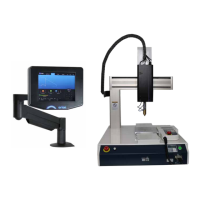49
Gas Cone. Looking directly at the flash could cause discomfort to the eyes.
Caution: e brass Gas Cone and Weld Cables can become hot to the touch during the weld process.
Exercise caution when handling directly after welding.
Chapter 10: Frequently Asked Questions
Q. WHAT IF MY WELD SPOT LOOKS DISCOLORED AND DARK OR HAS A LOT
OF PITTING?
•Make sure the argon tank is turned on and that you have at least 10psi going into the system.
•Make sure there are no kinks in the argon tubing.
•Check for leaks in the argon tubing. To do so, open the valve on the regulator until the system
pressurizes, then turn off the valve. If the PSI drops dramatically, there is most likely a leak.
•Make sure the inner diameter of the gas cone is cleaned from debris and that nothing is obstructing the
flow of Argon from the tip of the cone.
•Clean and re-sharpen the electrode.
•Clean the surface of the workpiece being welded and remove any coating/oxidation that may be present
at the weld location.
•Check the weld penetration depth. Make sure the material that the workpiece is resting on is not being
affected by the weld. Sometimes, if the weld penetration is deep enough to pass all the way through both
sheets being welded, non-metallic base materials or internal layers of a battery can actually melt and
become entrained in the weld spot.
Q. WHAT IF THE GAS CONE MAKES CONTACT WITH THE WORKPIECE, BUT
NO WELD TAKES PLACE?
•Clean and maintain the electrode (sometimes build-up on the electrode can interfere with arc
generation).
•Check Weld Timing on the Orion250i2 EV CNC. If the values are not correct, an arc may not be able to
initiate.
•Make sure the Orion 250i2 EV CNC is in “Play” mode (button on the lower left corner of the screen).
•Make sure the weld energy levels are set high enough for the material being welded.
•Make sure the green LED light on the front of the weld head is illuminated. e weld head must be plugged
in and powered on for a weld to take place.

